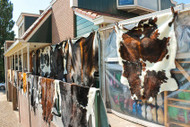The Process of Tanning Hides For Rugs
Sep 6th 2018
 Farm animals are good for more than just staring at and even mooing at as you drive by them on the highway. They are also good for their fine hides. Many of these hides may be used as rugs in your home. It is easy to create an amazingly unique product when such a hide is tanned properly.
Farm animals are good for more than just staring at and even mooing at as you drive by them on the highway. They are also good for their fine hides. Many of these hides may be used as rugs in your home. It is easy to create an amazingly unique product when such a hide is tanned properly.
The process of tanning animal hides for rugs isn't what you may think of when you hear the word "tanning." That is, this is not a process that entails something being stuck out in the sun with plenty of suntan lotion. It doesn't entail a tanning booth either.
The History of Tanning
The process of tanning hides has really evolved over the years. In the ancient times hides were first soaked in water to soften them and remove grime. Then they were beaten, removing fats and soaked in urine to remove the hair. Tanners would finally baste dung onto the skin and dip it into a salt solution.
A more modern method, a late nineteenth-century process promoted by the United States Department of Agriculture, required the user to use tannic acid from bark wood to take care of the pelt. It would take about three months, however, and nearly a hundred pounds of bark to use. Much of this entails getting tens of pounds of bark to soak in twenty boiled gallons of water for nearly three weeks.
How Does It Work?
Today a different process is used when tanning hides for rugs, other materials are used in place of urine and dung.
First, the animal has to be skinned quickly after death. The body heat of the animal makes removing the skin easier.
The excess water in the skin is then removed by curing the hide. This is to harden the surface of the skin. Salt is typically used in the curing process to enhance its quality. It can take two to four weeks for the curing process to be completed. Another method involves brine-curing or storing skins at a very low temperature.
The hide then moves into the liming stage. Lime or another basic agent is used to remove hair and grease. Sodium sulfide is then added to the skin to remove hair while a knife can help to shred off anything that might still be around.
The hide is then delimed and bated. Enzymes are applied to lower the pH of the collagen and soften the leather.
The final stage is pickling if the hide will be mineral tanned, salt and sulfuric acid are applied to bring down the pH so minerals can penetrate the hide. The mineral tanner can add a darker tone to the animal hide creating a different look.
Tanning Works For Different Animals
The tanning process for making leather rugs will vary based on the animal. First, there might not be a need to use as many materials to soften deer skin as it is naturally softer than a cow hide.
Meanwhile, cow hide will require you to add more compounds to keep the pH level down. Cow hide is known to be rather thick and sturdy.
Bear hides are somewhere in the middle. The best thing is to do is to place an emphasis on curing the hide as it is often harder to get it right after the animal is killed. This is due to how thickness of the skin.
While tanning hides at home can be a rewarding project, it does require knowledge, patience and the right materials.
Of course, you can buy the finished product pretty easily when you shop for Southwest rugs, including animal hide rugs, at Lone Star Western Decor.

